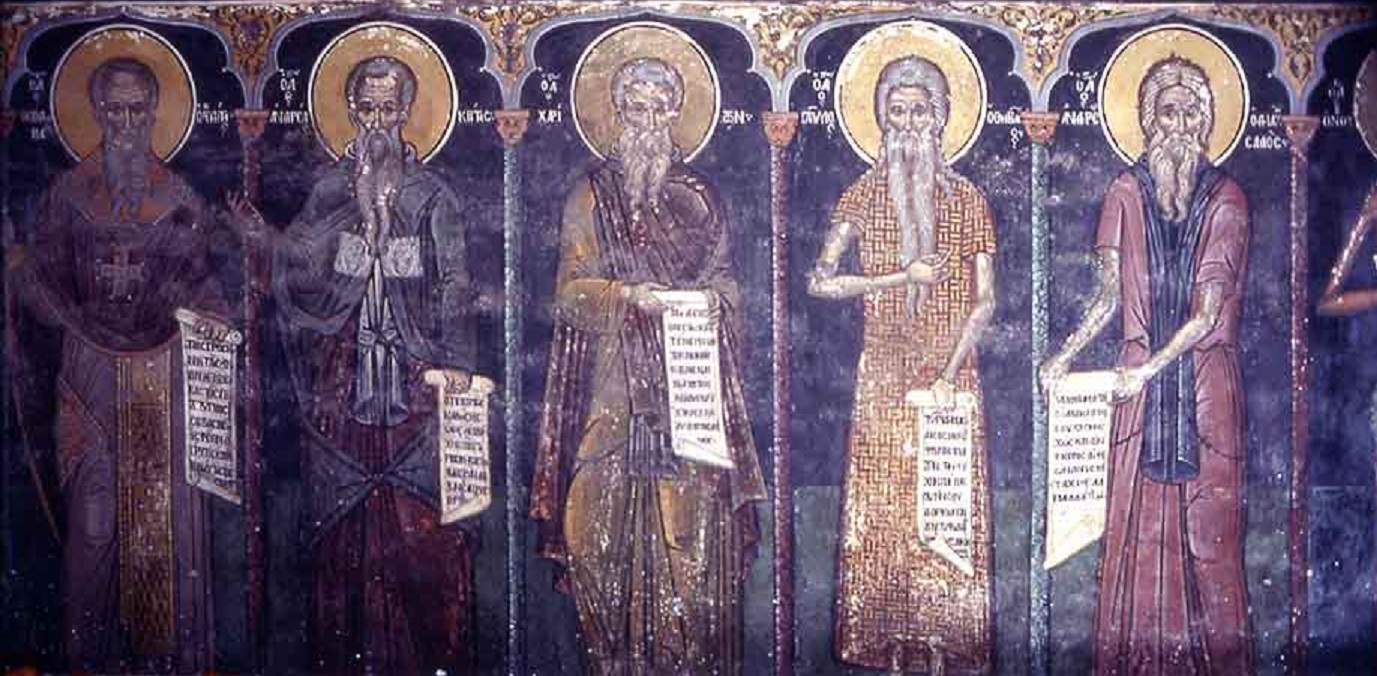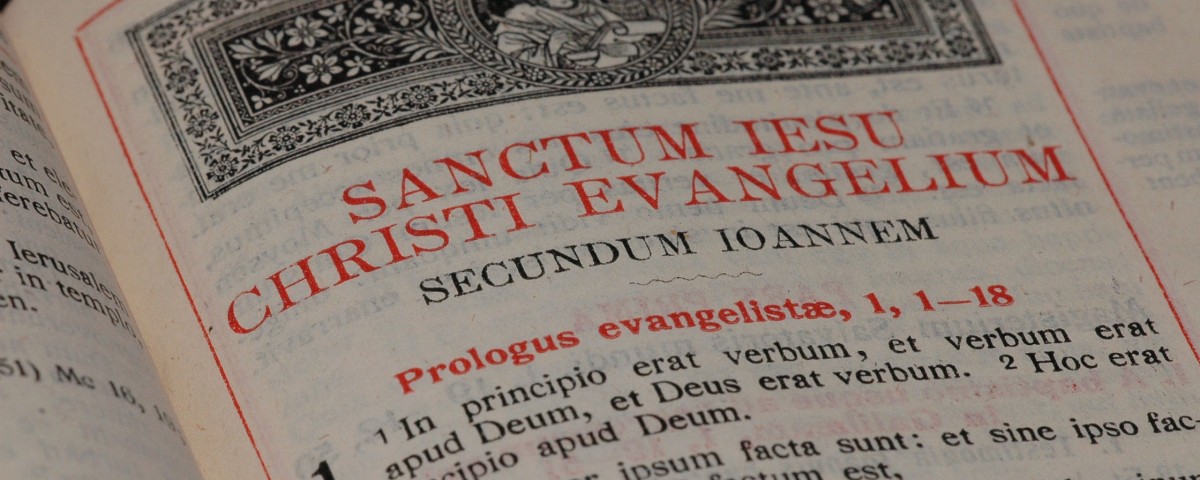
What Did the Early Church Fathers See in John?
January 7, 2016“And what God was the word was”

The writer of the Gospel of John was Jewish and therefore relied on an already established Hebraic way of thinking. This is reflected in the opening chapter to his Gospel where, in line with Jewish poetic prose, he personifies the concept of the logos.[1] This is a personification and not a person![2]
This logos is said to be “with God,” (John 1.1) but this doesn’t mean the logos is a person! Good evidence for this can be found in the “Hebrew prepositions im [‘with’, alone = in one’s consciousness, whether of knowledge, memory or purpose[3]] or et meaning ‘with’ [which can] describe the relationship between a person and what is in his heart or mind.”[4]
It comes as no surprise to find that other qualities of God are personified as well. For example: reward[5]; wisdom[6]; the law[7] and so on. At times, these qualities/personifications of the one God are given “a quasi-existence” of their own.[8] Such is the case with God’s word. For example, Dunn notes in his Christology in the Making that “in Rabbinic Judaism…there was a clear tendency to hypostatize (personify) the name of God[9], and the glory of God[10]. Here we might mention also the Memra [word] of Yahweh which is regularly named in place of Yahweh in the Targums” (pp. 129f.).[11]
In Psalm 105.19 “the word of God” is said to have “tested” the patriarch Joseph whilst in captivity; in Isaiah 2.3; Micah 4.2 “the word goes out from Jerusalem”; in 2 Chronicles 18.4 the king of Israel is told to “enquire (seek the council of) the word of God”[12]; and in Isaiah 55.11 God says “my word will not return to me empty without accomplishing what I desire, and without succeeding in the matter for which I sent it.” We also have modern-day expressions in English that personify “word”; for example “my word is my bond,” “I give you my word,” etc.
The characteristic force of its central term, ‘the Word’ or ‘Logos’, appears to be derived from Hebrew, not Greek, sources and from the atmosphere of Palestine rather than [the philosophical language] of Alexandria…[in the] early Jewish paraphrases on the Old Testament [the Targums], the ‘word’ of Jehovah (‘Memra’[13], ‘Debura’) is constantly spoken of as the efficient instrument of divine action, in cases where the Old Testament speaks of Jehovah Himself. ‘The word of God’ had come to be used personally, as almost equivalent to God manifesting Himself, or God in action…this means that the phraseology of [John] has its roots not in Platonic or Stoic idealism, but in the Jewish belief in the word of God, the manifestation of His will in creation or in revelation.[14]
From this we can understand how the writer is relying upon Jewish concepts that predate even his own. This extends across the NT and the way the writers portray the one God and Father of the lord Jesus Christ (2Cor 1.3; Rom. 15.6; 1Pe 1.3; John 20.17; Rev. 1.6).
It is because of these simple facts that some Bible versions render the last phrase of John 1.1c as: “…and what God was the word was.”[15] The logos when taken in context should be identified as God. That is to say, the subject of the prologue is God’s word, which is obviously not independent of that very same God! To try and make a distinction where there is none loses not only the style of the prologue but most importantly the writer’s intention and original meaning.
Grammatical points
Most translations inappropriately introduce the male pronoun “he” into John 1.1-2 where “he” replaces “this one”. [16] This prompts the reader into the mistake of thinking “the word” is a distinct person from its subject/source, God. Although Greek has grammatical gender (meaning nouns are masculine or feminine), this does not mean the reader should assign person-hood to them. For example, just because “word” (logos in Greek) is accompanied by masculine pronouns, it does not mean it is a person! To render it this way would be grammatical suicide!
Furthermore, the word translated “with” (pros) in the phrase “the word was with God” in John 1.1b “does not imply any movement or action on the part of the Logos,”[17] as if it were talking about one person next to (“with,” para[18]) another, in this case God. Hence the translation above best captures the meaning and intent of John 1.1c: “what God was the word was”; i.e. it was God’s word!
Apart from these grammatical points, the simple fact remains that in English “word” is an “it,” and not a “he.” The eight English translations from the Greek (not from the Latin Vulgate) before the 1611 KJV all have “it” instead of “he.”
It was the Roman Catholic Douay/Rheims version, translated from the Latin by Gregory Martin in 1582, which first rendered John 1:3, “all things were made by him,” rather than “by it” (the “word”).[19]
J.D.G. Dunn in his Christology in the Making notes:
It is only with verse 14 [‘the word became flesh’] that we can begin to speak of the personal Logos. The poem uses rather impersonal language (became flesh), but no Christian would fail to recognize here a reference to Jesus—the word became not flesh in general but Jesus Christ. Prior to verse 14 we are in the same realm as pre-Christian talk of Wisdom and Logos…dealing with personifications rather than persons, personified actions of God rather than an individual divine being as such.
The point is obscured by the fact that we have to translate the masculine Logos as ‘he’ throughout the poem. But if we translated Logos as ‘God’s utterance’ instead, it would become clearer that the poem did not necessarily intend the Logos of vv. 1-13 to be thought of as a personal divine being. In other words, the revolutionary significance of v. 14 may well be that it marks…the transition from impersonal personification to actual person.[20]
In John 1.1 “the word of God” is not a person apart from the one God. This would inevitably lead to a blurring of the One Person of God and a serious misunderstanding on the part of the reader as to how many God is.
Footnotes:
[1] Understood as “God manifesting His power in the world of matter or mind; a term used especially in the Targum as a substitute for ‘the Lord’ when an anthropomorphic expression is to be avoided.” Memra, jewishencyclopedia.org.
[2] “Philo’s ‘divine thought,’ ‘the image’ and ‘first-born son’ of God, ‘the archpriest,’ ‘intercessor,’ and ‘paraclete’ of humanity, the ‘arch type of man’…paved the way for the Christian conceptions of the Incarnation (‘the Word become flesh’) and the Trinity.” The Logos, jewishencyclopedia.org.
[3] Brown, Driver and Briggs, Hebrew and English Lexicon of the Old Testament, p. 768.
[4] Im: Num. 14:24; 1 Kings 11:11; 1 Chron. 28:12; Job 10:13; 15:9; 23:10; 23:14; 27:11; Ps. 50:11; 73:23. Et: Gen. 40:14; 2 Kings 3:12 (cp. John 17.5; 2 John 2; Gal. 2:5; Isa. 59:12; Jer. 12:3; 23:28; 27:18; 14:5; Prov. 2:1; 11:2. Buzzard, Hunting, Doctrine of the Trinity, pp. 195-96.
[5] Isa 40.10; 62.11; cp. Rev 22.12.
[6] Job 12.13, 16; Pro 1.20-23; 8.1-9, 12, 22-31.
[7] Isa 2.3; 51.4; Micah 4.2.
[8] Doctrine, p. 284.
[9] Yoma 3.8; 4.2; 6.2; and strikingly also in the Similitudes of 1 Enoch—39.7, 9, 13; 41.2, 6; 43.4; 45.2f.; 46.6-8; 47.2; 48.7, 10; etc.
[10] The Shekinah—e.g. Sanh. 6.5; Aboth 3.2; Targ. Onkelos on Ex. 33.14f.; 34.6, 9.
[11] G. H. Box, “The Idea of Intermediation in Jewish Theology: A Note on Memra and Shekinah,” JQR 23, 1932-33, pp. 103-19. Examples in Strack-Billerbeck 2, pp. 303f. Details of the usage in Targ. Neofiti and its possible significance may be found in R. Hayward, “The Memra of YHWH and the Development of its Use in Targum Neofiti 1,” JJS 25, 1974, pp. 412-18.
[12] Cp. Ps 33.4: “the word of God is right and true, He is faithful in all He does.”
[13] “In the Targum the Memra figures constantly as the manifestation of the divine power, or as God’s messenger in place of God Himself.” Memra, jewishencyclopedia.org.
[14] “In regard to this idea it must not be forgotten that, as found in some of the [Church] fathers, e.g. Justin and the Alexandrians, it has much closer affinities to Greek philosophy than it has in St. John” (Charles Gore, The Incarnation of the Son of God: being the Bampton lectures for the year 1891, p. 69-70, emphasis added).
[15] New English Bible (NEB); Revised English Bible (REV).
[16] houtos, see the TEV, LB, NASB, NIV, NRSV, NAB, AND the AB.
[17] “Support for this view may be found in the NT parallels where pros with the [accusative] often following the verb einai denotes not the linear motion but punctiliar [i.e, not moving] rest (Matt. 26.18, 55 vl.; Mk. 6.3 ( =Matt. 13.56); 9.19 ( = Lk. 9.41 but Matt. 17.17 has meth’ hymon); 14.49; 1Cor 16.6f.; 2Cor 5.8; 11.9; Gal 1.18; 4.18, 20; Phil 1.26; 1Thess 3.4; 2Thess 2.5; 3.10; Phlm 13; Heb 4.13; 1Jn 1.2)” (Brown, NIDNT, p 1204, emphasis added).
[18] “Elsewhere John uses para tini to express the proximity of one person to another (Jn. 1.39; 4.40; 8.38; 14.17, 23, 25; 19.25; cf. 14.23; note also meta tinos in Jn. 3.22, 25 f. etc.) or the nearness of the Son to the Father (Jn 8.38; 17.5), never pros tina” (Brown, NIDNT, p 1205, emphasis added).
[19] Anthony F. Buzzard, “John 1 and the word,” Focus on the Kingdom, v.9 n.12, Sept. 2007.
[20] J.D.G. Dunn, Christology in the Making, p. 243.

